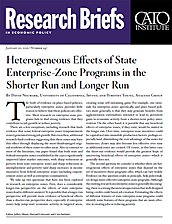The body of evidence on place-based policies, particularly enterprise zones, provides little reason to believe that these policies are effective. Most research on enterprise-zone programs fails to find strong evidence that they contribute to job growth or reduce poverty.
There are a few exceptions, including research that finds evidence that some federal enterprise zones (empowerment zones) generated strong job growth. But even then, additional research finds evidence suggesting that these zones may have this effect through displacing the most-disadvantaged original residents of these zones to other areas. Also in contrast to most of the literature, one paper found that both state and federal enterprise zones established in the 1990s significantly improved labor market outcomes, with sharp reductions in poverty from state enterprise zones and sharp reductions in unemployment and poverty (and sharp increases in income measures) from federal enterprise zones (including empowerment zones as well as enterprise communities).
We take up two questions that have not been explored in research on enterprise zones. First, does a considerably longer-run perspective on the effects of state enterprise zones lead to different answers? It is possible that a longer-run perspective will provide more evidence of beneficial effects than a shorter-run perspective does, especially if enterprise zones help jump-start economic activity in targeted areas, creating some self-sustaining gains. For example, one rationale for enterprise zones specifically, and place-based policies more generally, is that they may generate benefits from agglomeration externalities intended to lead to persistent gains in economic activity from a shorter-term policy intervention. On the other hand, it is possible that any beneficial effects of enterprise zones, if they exist, would be muted in the longer run. Over time, enterprise-zone incentives could be capitalized into immobile production factors, perhaps especially land, diminishing the cost advantage of the zones for businesses. Zones may also become less effective over time as additional zones are created. Of course, in this latter case the short-run evidence would provide the greatest hope of uncovering beneficial effects of enterprise zones—which it generally does not.
The second question we consider is whether there are heterogeneous effects of enterprise zones that depend on the set of incentives these programs offer, which can vary widely. Evidence on this question could, in principle, help policymakers design more-effective enterprise-zone programs. Although the existing research on enterprise zones is generally discouraging, there is a strong theoretical expectation that well-designed hiring credits could boost job creation. Estimating the effects of different features of state enterprise-zone programs could identify some features of these programs that are more effective at creating jobs or reducing poverty.
Moreover, there is a smattering of evidence pointing to some heterogeneity in the job-creation impacts of enterprise zones, suggesting that certain program designs and/or improved targeting could produce positive impacts. For example, the initial federal empowerment zones may have been more effective at creating jobs than subsequent versions of the policy (or other types of enterprise zones) because the initial empowerment zones included large block grants, which may have been spent on social services or other investments that boosted employment. In addition, prior research incorporated survey data from enterprise-zone administrators in an analysis of the effects of California’s state enterprise zones and found that a subset of efforts (e.g., marketing zone incentives) were associated with job gains. Finally, although one step removed from enterprise zones, recent work on general statewide hiring credits indicates that such credits are more likely to lead to job creation when governments can “claw back” the credits if businesses that claimed the credits fail to create jobs.
Given our emphasis on enterprise-zone program heterogeneity, we focus on state enterprise-zone programs, which differ along many dimensions. We estimate effects on outcomes related to wages and employment. The predicted positive effects on wages and employment from place-based policies like enterprise zones stem from a number of sources, including agglomeration, mitigating spatial mismatch, network effects on hiring (especially when local hiring is incentivized), and the direct impact of reducing labor expenses and other costs from tax credits or incentives. In particular, we analyze effects on the following five outcomes: the unemployment rate, the poverty rate, the fraction of households with wage and salary income, the average wage and salary income, and the level of employment.
Unfortunately, when looking at state enterprise-zone programs through a longer-term lens or the lens of program heterogeneity, neither leads to much if any consistent indication of beneficial effects of state enterprise-zone programs. Overall, we think this evidence should be interpreted cautiously. The data provide limited capacity to test for program heterogeneity, as there are not that many state programs to study and hence not a great deal of program variation. In addition, there could be richer dynamics associated with longer-run effects that our data do not capture. Moreover, there could be other sources of variation that are relevant, such as unmeasured initial economic (or other) conditions in the areas designated as enterprise zones.
Nonetheless, our evidence as it stands buttresses the generally negative assessments of the effects of enterprise zones. If one believes we still need to target policies for local economic development at the neighborhood level, then there is a strong case for both abandoning enterprise zones as we have implemented them in the past and considering radically different alternatives that could be more effective.
NOTE:
This research brief is based on David Neumark and Timothy Young, “Heterogeneous Effects of State Enterprise Zone Programs in the Shorter Run and Longer Run,” Economic Development Quarterly, January 2021, https://doi.org/10.1177/0891242420982341.
About the Authors

This work is licensed under a Creative Commons Attribution-NonCommercial-ShareAlike 4.0 International License.
